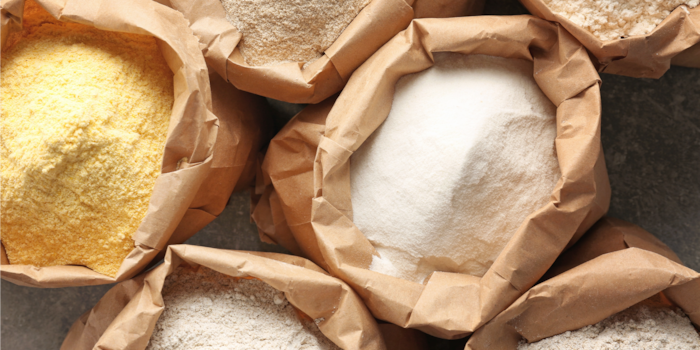
Guide
From IBS to gluten intolerance: your guide to enjoying bread responsibly
by Anna Sandner

Wheat is definitely the classic bread flour. But there are a whole host of alternatives, from spelt to einkorn, teff and Kamut.
Wheat is certainly the most well-known grain for bread making. The classic grain is popular in commercial baking because wheat is easy to produce and easy to store. Yields are also higher than with other grains. Wheat can be an important source of B vitamins such as niacin and folic acid and contains healthy amino acids and fibre. But it doesn’t agree with everyone. With a few exceptions, wheat contains more gluten than other grains. The high proportion of FODMAPs (fermentable oligo-, di- and monosaccharides and polyols) and rapid industrial production can lead to issues including irritable bowel syndrome.
You can find out more about how to make sure your chosen bread is good for you here:
Now let’s turn our attention to the numerous alternatives to wheat flour, some of which you may not have heard of before.
Rye: Rye is hardy and can be grown in regions where other crops don’t thrive. It was widespread until the 1960s, when it was replaced by wheat. Rye bread has a hearty flavour and is high in fibre, vitamins, and minerals. It contains less gluten (link in German) than wheat.
Barley: Barley is one of the oldest cultivated grains, having been used in bread and other foods for thousands of years. It can be adapted to different climates and grown in regions with cool climates. Barley bread has a slightly nutty flavour and is a good source of fibre, especially the soluble fibre beta-glucan.
Oats: Oats are often associated with muesli or oatmeal, but they’re also suitable for making bread. Oat bread is known for its mild and pleasant taste. It’s high in fibre, particularly beta-glucan, which can improve cholesterol levels.
Buckwheat: Although the name suggests it, buckwheat doesn’t belong to the cereal family; it’s a pseudocereal. Nevertheless, buckwheat is often used to make bread. Buckwheat bread has a distinctive, slightly earthy flavour that not everyone likes, and it’s rich in magnesium and iron. As a pseudocereal, buckwheat doesn’t contain gluten. However, it can come into contact with gluten from cereals, for example during transport and in mills.
Spelt: Spelt, also referred to as «ancient wheat», has a higher mineral content than conventional wheat, but it actually contains slightly more gluten than its modern counterpart. The ancient relative of modern wheat is rich in vitamin E – a powerful antioxidant that promotes cell protection. It has gained popularity as an alternative grain in recent years.
Einkorn: Einkorn is one of the oldest cultivated grains and was even found in the remains of the mummy Ötzi’s stomach. It’s known for its high mineral content, especially when compared to modern wheat. Einkorn is rich in iron, magnesium and zinc and contains important vitamins. However, it only yields about half as much as today’s wheat.
Teff: Dwarf millet is often grown in African countries, but it’s gaining popularity in other regions. Teff is naturally gluten-free, making it suitable as an alternative to cereals for people with gluten intolerances. However, contamination can occur during transport and processing. It’s rich in fibre, iron and calcium.
Kamut: Kamut, also known as khorasan wheat or oriental wheat, has larger grains compared to conventional wheat and it’s relatively unknown. Rich in amino acids, Kamut also contains an impressive amount of selenium, a trace mineral with antioxidant properties.
Whichever type of grain you use for your bread dough, one question is crucial when it comes to health: whole grain or white flour?
In addition to the grain used, the proving time determines how easy to digest your bread is. But when it comes to how healthy bread is for you, the main difference is whether you use wholemeal flour or white flour. And the answer is very clear: whole grain is healthier – no matter what flour it is. This is because whole wheat flour is made from the entire grain, including the germ, husk and endosperm (the nutrient tissue in the grain). In contrast, white flour (also called refined flour) is only extracted from the inner part of the grain, which means that many valuable nutrients in the outer layers of the grain are lost.
As a result, wholemeal flour contains more fibre, minerals such as potassium and magnesium and important B vitamins. Dietary fibre is essential for healthy digestion and promotes satiety. If you eat whole-grain bread, you will stay full for longer than if you eat bread made from white flour. The fibre and nutrients in whole grains also help keep blood sugar levels stable, preventing cravings.
The rich minerals in whole-wheat flour play an important role in supporting heart health and preventing colon cancer. Potassium helps regulate blood pressure and magnesium is essential for muscle and nerve function. And the B vitamins provide energy and support the metabolism. Not only is whole-wheat bread a delicious way to incorporate the benefits of whole grain flour into your daily routine, regular consumption of whole grains can reduce your risk of heart disease, diabetes and certain types of cancer. So, remember that healthy can be tasty!
Header image: Africa Studio/Shutterstock
Science editor and biologist. I love animals and am fascinated by plants, their abilities and everything you can do with them. That's why my favourite place is always the outdoors - somewhere in nature, preferably in my wild garden.
Practical solutions for everyday problems with technology, household hacks and much more.
Show all